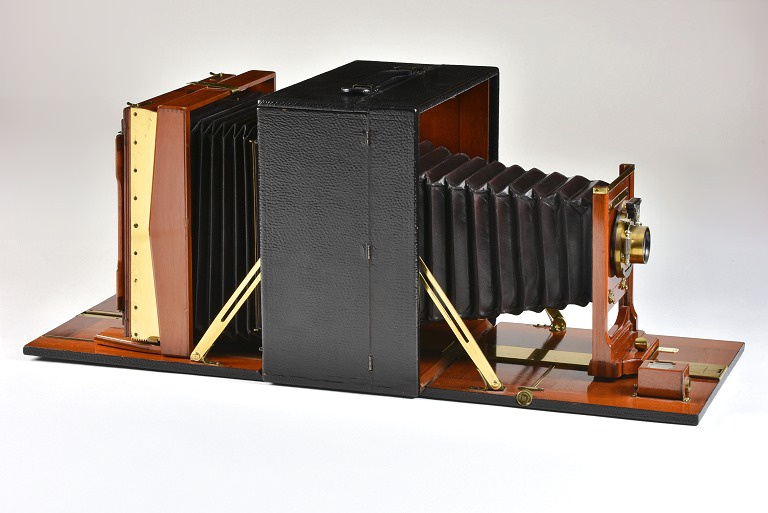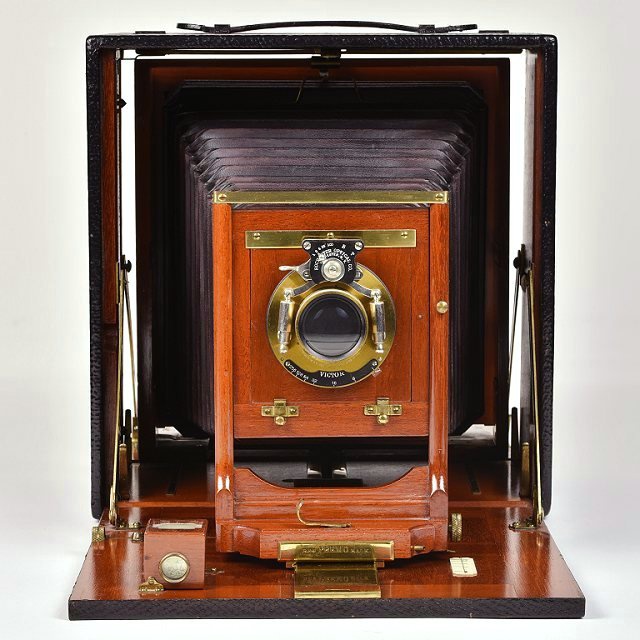|
|




Copyright ©2005 - 2015 by Rob Niederman - ALL RIGHTS RESERVED
Return to the Self-Casing Cameras page
In 1897, the Rochester Optical Company announced a major design variation of
the traditional folding plate camera. To be able to use long focal length lenses,
the back drops down like the front. This permits an extra long bellows draw for
telephoto photography, enlarging, and copying.
The expansive polished wood interior, brass trim and maroon bellows makes this one of the most impressive American folding plate cameras. These larger format ‘long focus’ models are uncommon and typically in very poor condition through years of hard professional use.
This particular example appears in catalogues from 1897 to 1900 and shoots nice sized 6½ x 8½ inch (whole-plate) format glass plates. When fully extended, it is 30 inches long. As an advanced amateur / professional camera it wasn’t cheap and advertised for $62.00 in 1897 (equal to about $1,736 in 2014 currency!).
This model camera was also used by the famous American western photographer Edward Curtis. A picture of Curtis' whole-plate Reversible Back Premo can be seen on a webpage maintained by the Smithsonian Institution Library. The Curtis website is also worth a visit at: www.sil.si.edu/Exhibitions/Curtis
The Victor Flat-Top shutter indicates this is an 1900 model made by the Rochester Optical Company. The camera continued to be offered by the Rochester Camera & Optical Company until it was acquired by George Eastman and merged with Kodak in 1903. R.O.& C. Co. versions have a redesigned lens board mount and improved front and rear focusing with course and fine adjustments.
The expansive polished wood interior, brass trim and maroon bellows makes this one of the most impressive American folding plate cameras. These larger format ‘long focus’ models are uncommon and typically in very poor condition through years of hard professional use.
This particular example appears in catalogues from 1897 to 1900 and shoots nice sized 6½ x 8½ inch (whole-plate) format glass plates. When fully extended, it is 30 inches long. As an advanced amateur / professional camera it wasn’t cheap and advertised for $62.00 in 1897 (equal to about $1,736 in 2014 currency!).
This model camera was also used by the famous American western photographer Edward Curtis. A picture of Curtis' whole-plate Reversible Back Premo can be seen on a webpage maintained by the Smithsonian Institution Library. The Curtis website is also worth a visit at: www.sil.si.edu/Exhibitions/Curtis
The Victor Flat-Top shutter indicates this is an 1900 model made by the Rochester Optical Company. The camera continued to be offered by the Rochester Camera & Optical Company until it was acquired by George Eastman and merged with Kodak in 1903. R.O.& C. Co. versions have a redesigned lens board mount and improved front and rear focusing with course and fine adjustments.
Multi-Lens Cameras | View Cameras | Self-Casing Cameras | Solid Body Cameras | References & Advertisements
Home | What's New | Show Schedule | Wanted | For Sale | Links | Site Map | Email
Home | What's New | Show Schedule | Wanted | For Sale | Links | Site Map | Email
Reversible Back Premo, 1897-c.1903
Rochester Optical Company. Rochester, NY.
Rochester Optical Company. Rochester, NY.
Front view of the Rev Back with Victor Flat Top shutter.
Size is 6-1/2 x 8-1/2 inch format.
Extra bellows draw is obtained by means of a folding back which drops and forms a bed for the rear portion of the camera.
The rear standard has an adjustable tilt (large brass hardware) for distortion control.
The rear standard has an adjustable tilt (large brass hardware) for distortion control.